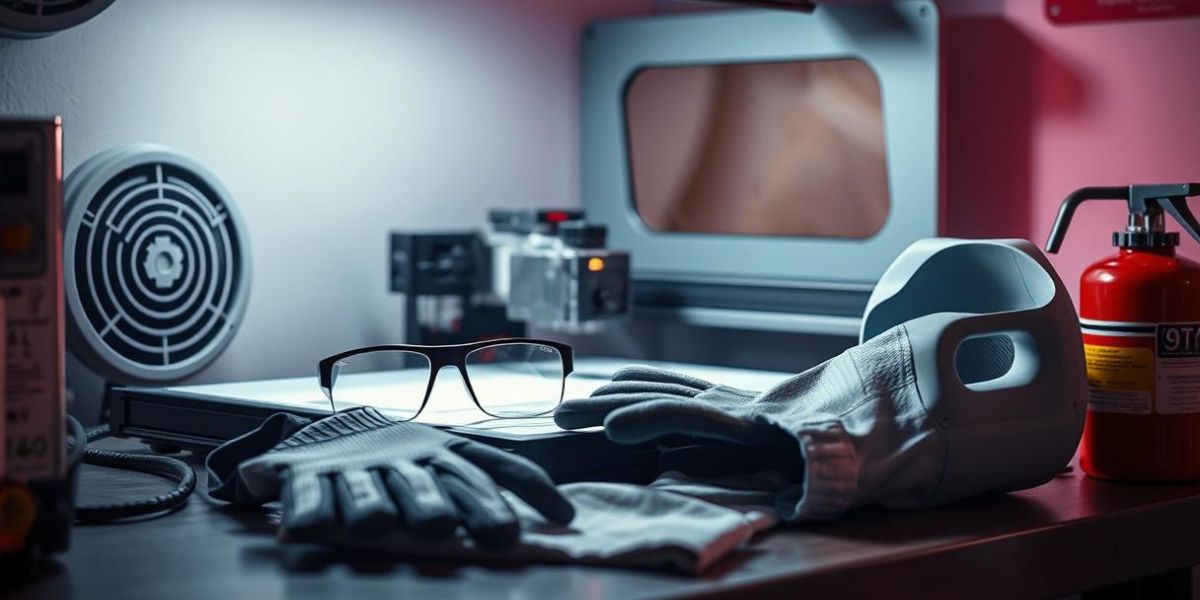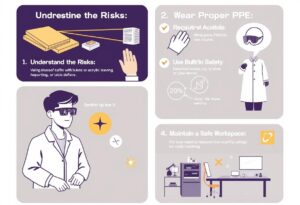
What Precautions Should Be Taken During Laser Engraving for Safety and Precision?
Laser engraving machines are powerful tools but they carry serious hazards even benchtop engravers like those distributed by Protomont Technologies popular brands xTool, Elegoo and Snapmaker use intense beams and high voltages. Without care you risk eye injuries, burns, toxic fumes or even fire always approach laser engraving with safety first. Understand the risks laser radiation, electrical shock, fire and follow strict precautions at every step.
Understand the Risks
Laser beams can cause instant permanent eye or skin damage and ignite materials. For example, Thunder Laser warns that laser radiation is a “significant risk,” causing severe eye damage and burns if unprotected. High heat or sparks can start fires, especially in wood, paper or fabrics toxic fumes from PVC or certain plastics can injure lungs. Educate yourself on your specific machine CO₂, fiber or diode and material hazards. Read the user manual thoroughly and heed all warning labels.
Wear Proper PPE
Protective gear is mandatory always wear laser rated safety glasses that match your machines wavelength use work gloves and clothing to shield against burns or sparks. For example:
- Laser safety glasses: Rated OD4+ for CO₂/infrared or the correct wavelength. This blocks harmful beams.
- Protective clothing: A lab coat or apron cotton or leather shields skin from laser reflections or debris.
- Inspection: Regularly check your PPE cracked lenses or frayed gloves can fail when needed.
Equipping and inspecting PPE helps prevent eye and burn injuries.
Use Built-In Safety Features:
Most modern laser engravers include safety interlocks, stops and sensors. For example the xTool S1 has a lid interlock: opening the lid immediately shuts off the laser, preventing stray beams. Key safety features to use and test:
- Emergency Stop Button: Know its location. It lets you instantly cut power in an emergency fire, smoke or equipment failure.
- Door/Lid Interlocks: Never defeat them. These sensors stop the laser if a cover is opened.
- Enclosures and Shields: CO₂ laser machines have metal cabinets with view windows; diode lasers often have tinted hoods. Keep these in place. Even with enclosures, wear your safety goggles.
- Smoke/Flame Detectors: Some systems include fire or smoke sensors. Make sure they’re enabled.
Brands like xTool and Elegoo build in these protections but they don’t replace operator care. Always keep safety features in working order test interlocks and buttons periodically.

Maintain a Safe Workspace:
Set up your laser engraver in a dedicated area for safety and precision the OMTech guide recommends a stable level well ventilated space away from dust humidity or direct sun.
Key workspace precautions:
- Ventilation: Use an exhaust fan or fume extractor to remove smoke and odors proper ventilation prevents buildup of toxic gases and reduces fire risk.
- Clutter-Free Zone: Area around the machine clear of papers, cloths, solvents and other combustibles flashback and debris can start a fire if flammables are nearby.
- Fire Safety: Suitable fire extinguisher e.g. CO₂ or dry chemical within reach check that it’s charged and unexpired and ensure everyone knows how to use it install a smoke detector if possible.
- Electrical Safety: Grounded outlet for the laser machine do not overload circuits or run extension cords through walkways keep all cables organized to avoid tripping.
Prepare Materials Carefully:
Choosing and handling materials correctly is critical for safety and precision Not all materials are safe to engrave for example xTool explicitly forbids PVC or vinyl since burning chloride plastics emits deadly fumes. Always:
- Use Approved Materials: Only engrave materials known to be safe like wood, acrylic, anodized aluminium avoid plastics or laminates unless confirmed safe check manufacturer guides or material databases before starting.
- Secure the Workpiece: Clamp or tape your material firmly to the bed even slight shifting during the run can ruin your design and potentially break the laser head rigidly fix oddly shaped pieces e.g. using a rotary attachment to prevent movement.
- Clean Surfaces: Remove labels, oils or dust from the material beforehand contaminants can affect engraving quality and even catch fire.
Ensure Precision: Calibration and Focus
Beyond safety, precision requires careful setup. A wellcalibrated machine yields crisp repeatable engravings Key steps include:
- Focus the Beam: Always set the laser focus at the materials top surface. A poorly focused beam spreads out wider kerf giving blurry or shallow results. Use autofocus if available or a focus gauge.
- Calibrate Axes: Verify your X/Y motion is accuratev for example cut a known size square and measure it. If it’s off, adjust the machines steps permillimeter constant air flow clears smoke and cools material, resulting in cleaner edges and better accuracy until the cut is true. Also check for squared gantry equal diagonals to avoid skew.
- Choose Resolution Wisely: DPI dots per inch affects detail and speed higher DPI gives finer detail but slower engraves; too high and marks overlap. Match DPI to your material e.g. 250–333 DPI for wood/glass 600+ DPI for fine metal engraving snapmaker.
- Use Air Assist: If your machine has air or airbrush use it. A
Proper calibration and focus not only improve quality but also prevent repeated passes that increase fire risk. Taking time to set up means consistent, precise results every run.
Regular Maintenance & Training
A well maintained laser is a safe precise laser Follow these care tips:
- Clean Optics: Dust on lenses or mirrors reduces cutting power and can cause defocusing regularly wipe down the laser lens, mirrors and honeycomb bed with a soft cloth or canned air avoid solvents unless specified by the manufacturer.
- Inspect Wearable Parts: Check belts bearings and wiring each month look for frayed belts loose pulleys or torn cables replace worn parts immediately a failing belt can slip midjob, ruining precision or worse causing a mechanical jam.
- Test Safety Systems: Periodically test the emergency stop, interlocks and sensors. Make sure the lid switch truly cuts the laser and that the E-stop works from any position.
- Follow the Manual: Adhere to the manufacturers maintenance schedule this includes lubrication, filter changes and software updates proper upkeep extends machine life and prevents malfunctions during engraving.
- Get Training: Ensure operators are trained on the specific laser model read the user guide carefully. Understand the control software and correct settings for each material. Even simple errors wrong focus distance, too high power can cause accidents or damage.
By investing in routine care and learning, you minimize surprises. The xTool support page reminds users to “read and get familiar with all safety precautions” and keep the workspace clean. Never skip maintenance leave novices unsupervised.
Safety and precision go handinhand for successful laser engraving as Protomont Technologies emphasizes following these precautions lets you enjoy creative, highquality results without accidents. Whether using a Protomont laser system or a popular model like an xTool, Snapmaker or Elegoo Laser Engraver Machine always wear PPE use safety features and work in a safe environment. Train thoroughly, monitor every job and maintain your machine.
Protomont Technologies offers a range of laser engravers and 3D printers engineered with these safety features. Contact us to explore equipment with robust interlocks air filtration and support for any user’s skill level. We’ll help you set up your workspace choose the right materials, and answer your questions so you can engrave confidently and achieve the best precision.
Talk to Protomont Technologies today to find the right laser engraving machine and get started safely on your next project!
Frequently Asked Questions
- Can I laser engrave leather: Yes leather can be engraved with a CO₂ or suitable diode laser to create designs on wallets, belts, etc use low to medium power and high speed to avoid burning and always ventilate well leather can emit smoke. Test on a scrap piece first to set the best parameters.
- What is DPI in laser engraving: DPI stands for dots per inch it controls engraving resolution higher DPI means finer detail but slower speed. For example 250–333 DPI is often used for wood while 600+ DPI is used for photo engraving on coated metal. Too high DPI can cause “dot bleed” and reduce clarity so choose DPI based on your material and design.
- What is a laser cutting machine: A laser cutting or engraving machine uses a focused laser beam to cut etch or mark materials. It consists of a laser source CO₂ tube, fiber or diode and CNC driven optics. By moving the beam precisely it vaporizes or melts material along a path laser cutters can handle wood, acrylic, metal, leather and more depending on laser type and power.
How much does a laser engraving machine cost: Entry level diode engravers start around a few hundred dollars while larger CO₂ systems run into the thousands price depends on power, build quality and features. Specialty industrial machines can cost $10,000+. Consider what materials you need to work with then choose a machine from brands like Protomont Technologies range xTool, Elegoo, Snapmaker etc. that meets those needs.

